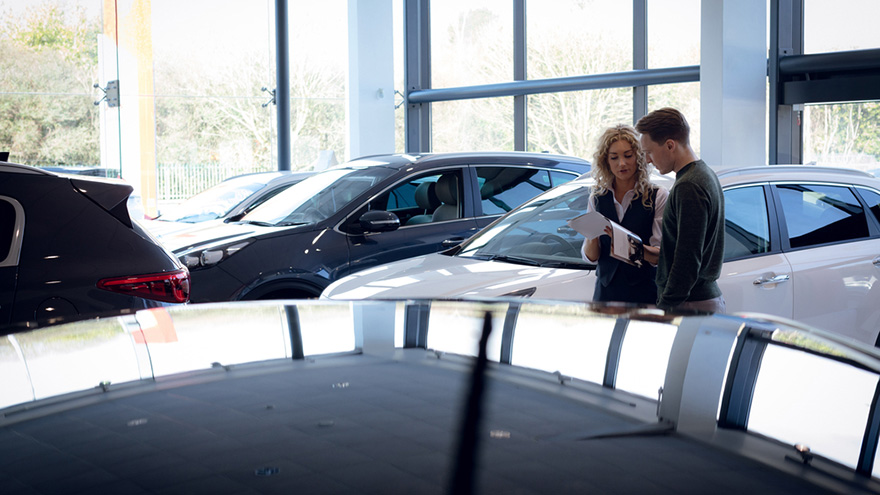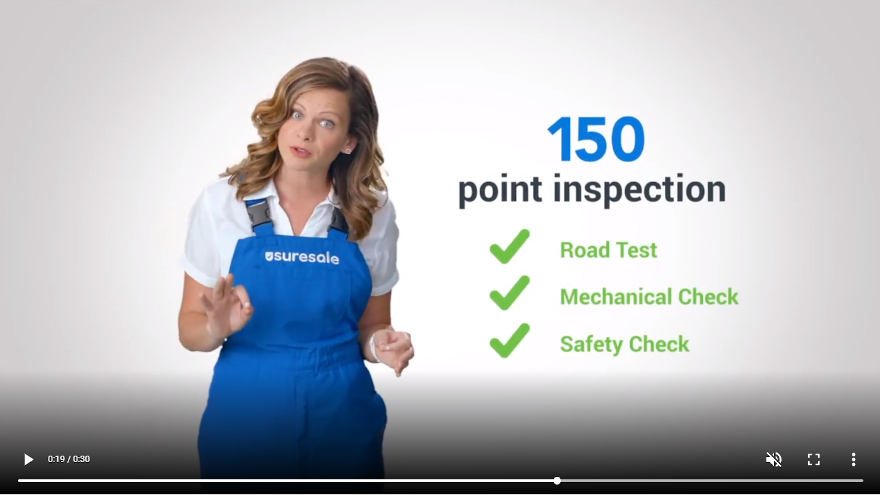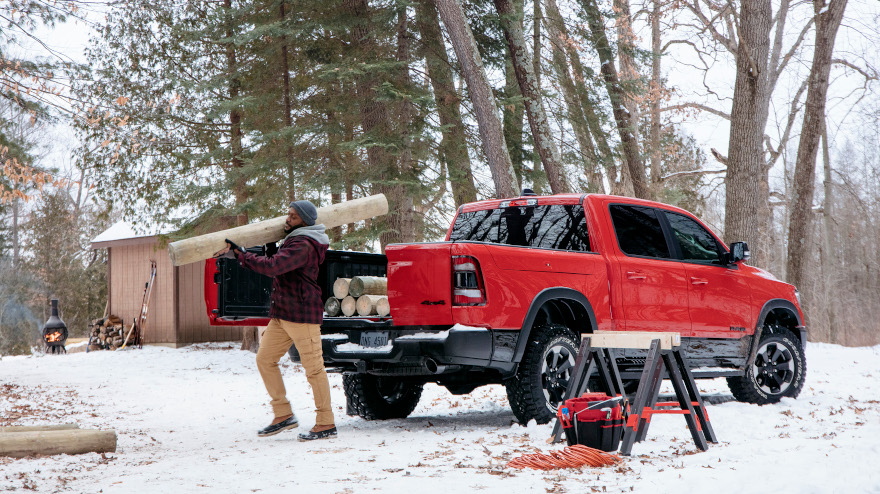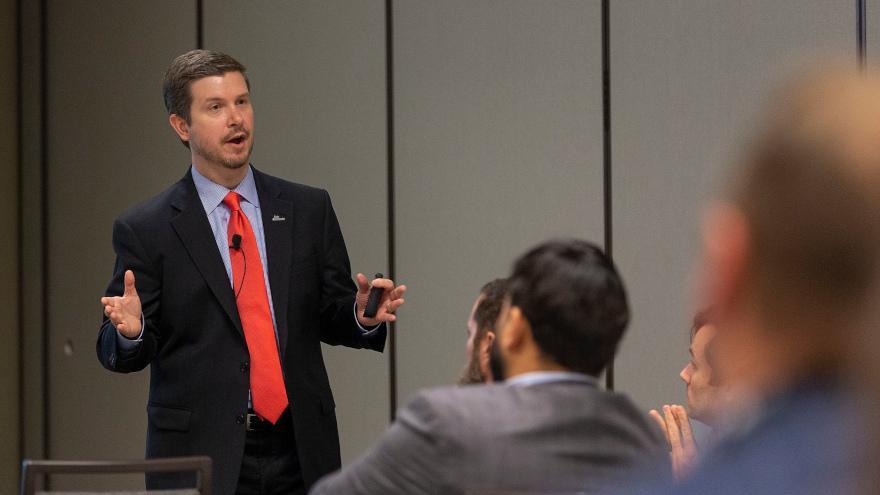Certified wholesale vehicles sell faster and at rates 4 to 8% higher than their uncertified counterparts, according to a recent white paper from Manheim Consulting.
The paper, titled, “Certification Impact on Low Grade & High Mileage Units,” also showed that certification can mean one-third fewer arbitrations.
According to the white paper, the benefits and returns of certification are even greater as mileage goes higher than 75,000. That, according to the company, is a signal of buyers’ willingness to pay a premium for the guarantee of a mechanically sound unit.
That can be the case even at a lower grade or higher mileage, the company said.
Manheim Consulting added that giving buyers confidence in their purchases is the key to making the sale. Certifications for older and high mileage cars can give buyers the confidence they need to purchase vehicles faster. They can also mean a competitive edge and stronger profits for sellers.
Manheim says its own certification program, Manheim Certified, can improve profit margins for the seller and protect the interests of all involved parties. The program, according to the company, gives buyers more confidence to do business by providing them with a seven-day, 300-mile guarantee.
The company responds if a repair is needed. Manheim will repair the vehicle in-house or cover the costs of the repair.
Or, in periodic cases, Manheim will take the vehicle back.
Under the program, Manheim Certified unit sellers don’t have to worry about arbitration, according to the company, because the company removes the seller from the post-sale claims process.
Manheim says additional benefits and competitive advantages of certifications can be 6.6% more Simulcast sales, 48% wider Simulcast audience reach, and more bids per vehicle.
For Manheim Certified, which is available to all sellers in the Manheim marketplace, vehicles must be under 125,000 miles.
Also to qualify, they must have an InSight Condition Report and be on-site.
“Manheim’s goal is to build trust and confidence between buyers and sellers within the wholesale market,” Cox Automotive vice president of Assurance Brett Woods said in a news release.
Woods added, “While this data reinforces that vehicles with Certifications are at an advantage, we’re also reminded that giving buyers assurance before the sale is the best way to create a positive experience and earn loyalty.”
Certified pre-owned vehicle sales continue to be a bright spot for franchised dealerships this year, and KAR Auction Services chief economist Tom Kontos explained how those vehicles that become CPO units helped consignors and the wholesale market in July, too.
According to ADESA Analytical Services’ monthly analysis of wholesale used vehicle prices by vehicle model class, wholesale used vehicle prices in July averaged $11,452, representing a 0.2% softening compared to June but a 5.1% lift relative to July of last year.
Kontos pointed out all vehicle segments showed month-over-month declines in average prices except compact cars, compact pickups and full-size pickups; just some of the segments ripe for CPO.
“Average wholesale prices in July were flat relative to June and remained up on a year-over-year basis largely on the price strength and growing share of truck-segment sales. CPO sales continue to buoy off-lease vehicle prices,” Kontos said.
Based on data from the National Automobile Dealers Association, he continued in his latest installment of the Kontos Kommentary that July retail used vehicle sales by franchised and independent dealers dipped 2.1% month-over-month and 1.9% year-over-year.
While July CPO sales were down 1.8% from the prior month, Kontos pointed out they rose 6.0% year-over-year, according to figures from Autodata. On a year-to-date basis, Kontos noted CPO sales are 1.9% higher versus last year.
Besides the previously mentioned trio of vehicle segments that stayed strong in July, Kontos also highlighted significant upward movements by two other specific kinds of vehicles that oftentimes land in dealership CPO inventory. He looked at midsize cars and midsize SUV/CUVs while holding constant for sale type, model-year age, mileage and model class segment — criteria that typically characterize off-lease units.
For those midsize cars, wholesale prices jumped $501 or 4.1% to $12,670. For those midsize SUV/CUVs, wholesale prices moved up even more, rising by $783 or 3.8% to $21,323.
Kontos wrapped up his latest look at the wholesale space by mentioning average wholesale prices in July for used vehicles remarketed by manufacturers rose 2.7% month-over-month and 6.1% year-over-year.
He spotted that July prices for fleet/lease consignors edged up 0.4% sequentially and 4.3% annually.
Kontos added that average prices in July for dealer consignors slid 1.2% versus June but jumped 4.1% relative to a year earlier.
ADESA Wholesale Used-Vehicle Price Trends
| |
Average |
Price |
($/Unit) |
Latest |
Month Versus |
| |
July 2019 |
June 2019 |
July 2018 |
Prior Month |
Prior Year |
| |
|
|
|
|
|
| Total All Vehicles |
$11,452 |
$11,478 |
$10,892 |
-0.2% |
5.1% |
| |
|
|
|
|
|
| Total Cars |
$8,654 |
$8,688 |
$8,511 |
-0.4% |
1.7% |
| Compact Car |
$6,609 |
$6,550 |
$6,427 |
0.9% |
2.8% |
| Midsize Car |
$7,444 |
$7,474 |
$7,449 |
-0.4% |
-0.1% |
| Full-size Car |
$7,886 |
$7,921 |
$7,258 |
-0.4% |
8.6% |
| Luxury Car |
$13,347 |
$13,456 |
$13,295 |
-0.8% |
0.4% |
| Sporty Car |
$14,673 |
$14,981 |
$14,213 |
-2.1% |
3.2% |
| |
|
|
|
|
|
| Total Trucks |
$13,618 |
$13,637 |
$12,914 |
-0.1% |
5.5% |
| Minivan |
$8,404 |
$8,626 |
$7,927 |
-2.6% |
6.0% |
| Full-size Van |
$13,082 |
$13,100 |
$13,309 |
-0.1% |
-1.7% |
| Compact SUV/CUV |
$11,173 |
$11,224 |
$10,793 |
-0.5% |
3.5% |
| Midsize SUV/CUV |
$11,774 |
$11,885 |
$10,984 |
-0.7% |
7.2% |
| Full-size SUV/CUV |
$14,084 |
$14,736 |
$13,185 |
-4.4% |
6.8% |
| Luxury SUV/CUV |
$18,839 |
$19,081 |
$18,498 |
-1.3% |
1.8% |
| Compact Pickup |
$11,345 |
$11,017 |
$9,790 |
3.0% |
15.9% |
| Full-size Pickup |
$17,479 |
$17,243 |
$16,578 |
1.4% |
5.4% |
Source: ADESA Analytical Services.
Meet “Shirley,” the new brand ambassador for SureSale Certified.
The company, which describes itself as “the gold standard for quality used vehicles and purchase protection,” launched a new multi-channel advertising campaign centered around Shirley, who SureSale describes as a “trusted advisor.”
According to the company, Shirley helps consumers understand that with SureSale, they can “Be Sure” that their SureSale Certified vehicle will be a quality one. The campaign premiered in the Louisville, Ky., market, with plans to expand to other U.S. markets in the coming months.
“We created a whole new category of used vehicle with SureSale Certified, so it was critical that we support it with a marketing campaign that both educates consumers and inspires them to opt for a SureSale Certified vehicle – all while being whimsical enough to entertain,” SureSale president and co-founder Jeffrey Schwartz said in a news release. “With Shirley, we have generated a broadcast campaign that embodies SureSale Certified, as well as distinctive point-of-sale merchandising that will give our auto dealer partners a competitive edge.”
To find a spokesperson to help car buyers understand why they should buy a SureSale Certified vehicle — and to reflect the essence of SureSale — the company conducted a nationwide search.
“We believe that SureSale is a truly disruptive and truly positive development for the auto industry, offering benefits for both car buyers and auto dealerships alike,” said SureSale chief executive officer and co-founder Donny Hall. “With humor, Shirley offers confidence and clarity to used-car buyers, and we are sure that consumers will soon be heading for dealerships that offer SureSale vehicles.”
SureSale Certified vehicles are currently available at dealerships around the country. They come with a free CAReport (comprehensive auto report), clean title, 150-point inspection, a five-month, 5,000-mile comprehensive warranty, a five-day exchange guarantee, and extended protection plans.
SureSale says when consumers know the past, present and future of each SureSale Certified vehicle, they can “buy with confidence and own with peace of mind.”
For dealers, SureSale says they have a consumer-friendly selling proposition that helps them turn vehicles faster during what the company describes as an ongoing market shift to used vehicles. The company describes Shirley as an important component of the marketing dealership toolkit that helps dealers sell SureSale Certified vehicles.
As the decline in new-vehicle sales continues, SureSale says more consumers want the assurance of a certified pre-owned vehicle. But the company says that because of automaker program brand restrictions, only a fraction of auto dealership inventories are CPO vehicles. SureSale Certified expands the number of certified vehicles that dealerships can offer consumers.
SureSale Certified allows auto dealerships to extend consumer protections to a wider range of vehicles, which the company says is similar to auto manufacturer CPO programs. That range is up to 15 years, 150,000 miles for more than 20 brands.
The following features come standard with SureSale Certified vehicles:
— Clean VIN and free CAReport (Comprehensive Auto Report)
— 150-point certified inspection
— Five-month/5,000-mile comprehensive warranty
— Five-day exchange guarantee
— Extended protection plans up to 36 months or 36,000 miles
The Ram brand at FCA US made quite a splash in the new-vehicle market last month, hitting its best sales month since becoming a standalone brand a decade ago.
The stats are quite impressive: June’s sales of 68,098 units were a 56% increase, according to FCA.
That begs the question: Is Ram’s success on the new-car side also being seen in certified pre-owned, as well?
It would appear so.
There were 4,739 CPO Ram vehicles sold in June, a 7.9% year-over-year increase, said Eric Swanson, who is head of certified pre-owned vehicles at FCA.
The year-to-date improvement (16.4%) is even stronger, with 28,311 CPO Ram sales through June.
“It's no surprise that the Ram 1500 is our number one selling CPO vehicle,” Swanson said in an email. “I think our big driver of success is our dealers recognize customers want a great used Ram truck with a CPO warranty backed by the factory.
“Dealers can get them at our auctions, they can get them as lease returns, they can get them in trades and by stocking those they have all kinds of options with a customer,” he said.
“Once they are inspected, reconditioned and certified, the traditional used-vehicle buyer has an amazing truck with peace of mind with the CPO,” Swanson said. “Then we have the new body style Ram with incredible looks and performance, so moving them over to the new truck is very easy to do.
“They really feed off each other.”
Going back to the new-vehicle market, June was the third time since December that there have been more than 60,000 new Rams sold, head of U.S. sales Reid Bigland said in a news release.
“For the first-half of 2019, Ram has been on a tear since we made the strategic decision to enter the year with a three-truck strategy. The new Ram 1500, Ram Classic and Heavy Duty are all generating a huge response from customers and critics alike,” Bigland said. “This is now the third month Ram pickup sales have surpassed 60,000 since December. Our dealers had a steady stream of customers all month long.”
Signs are pointing to another best-ever year for the certified pre-owned market.
There were 1.16 million CPO vehicle sales in the first five months of the year, according to Tuesday’s Data Point report from Cox Automotive, beating year-ago figures by 2%.
May continued what has now been a three-month streak of certified sales increases, following a slow start to 2019. Cox Automotive said there were about 252,000 CPO sales in May, up from 249,000 a year ago.
The company said the certified pre-owned market is “growing at a comfortable pace,” with this likely to be the ninth straight record year.
“As the used-vehicle market continues to see strong consumer demand with ample supply of off-lease units coming to market, the CPO market is primed to continue to see favorable growth and is on pace to set another record,” Cox Automotive analysts said.
As for the overall used-car retail market, franchised dealers increased used-car sales by 1.4% year-over-year in May while independents saw their used sales dip 1.0%, KAR Auction Services chief economist Tom Kontos said in his monthly report, citing data from the National Automobile Dealers Association.
Sharing data from the first quarter, Edmunds said in its latest Used Vehicle Report that there were 10.45 million used-vehicle sales in Q1, down from 10.62 million used sales a year earlier.
Franchised dealers, though, increased their used-car sales from 2.97 million to 3.11 million for the quarter, according to Edmunds.
Along with touching on the latest certified pre-owned sales data he could share, KAR Auction Services chief economist Tom Kontos used a gardening analogy to describe how the spring wholesale market reached “full bloom in April.”
According to ADESA Analytical Services’ monthly analysis of wholesale used-vehicle prices by vehicle model class, analysts reported that wholesale used vehicle prices in April averaged $11,489, up 3.6% compared to March and up 3.4% relative to April of last year.
Kontos noted full-size cars and minivans were the only segments that did not show month-over-month average price increases, and their declines were modest.
The spring/tax season market reached full bloom in April as average wholesale prices reached what will likely be peak or near-peak levels for the year based on historical seasonal trends,” he said in the latest Kontos Kommentary released just before Memorial Day weekend.
“Car prices moved in parity with truck prices overall on a month-over-month basis and showed particular strength in the off-lease segment at physical auctions,” Kontos added.
Kontos continued his regular analysis by revisiting trends involving units that typically can be within a dealership’s CPO inventory.
When holding constant for sale type, model-year age, mileage, and model class segment — using criteria that characterize off-lease units — Kontos discovered prices jumped significantly on a year-over-year basis for midsize cars but dropped substantially for midsize SUV/CUVs.
Prices for those particular midsize cars climbed 4.5% or $542 to $12,648, while prices for those specific midsize SUV/CUVs softened 1.3% or $279 to $20,902.
Kontos went on to mention more ADESA data from April that revealed average wholesale prices for used vehicles remarketed by manufacturers rose 2.9% month-over-month but slid 1.6% year-over-year.
Prices for fleet/lease consignors increased 4.4% sequentially and 4.3% annually.
Average prices for dealer consignors moved 3.6% higher versus March and 1.1% relative to last April.
Finally, based on Edmunds data, Kontos recapped that retail used-vehicle sales by franchised dealers rose 3.8% year-over-year in April and 2.4% year-to-date.
He went on to point out April CPO sales dropped 12.6% from the prior month’s record levels but edged 1.3% higher year-over-year, according to figures from Autodata.
On a year-to-date basis, CPO sales are up 1.7% versus last year, Kontos concluded.
ADESA Wholesale Used-Vehicle Price Trends
| |
Average |
Price |
($/Unit) |
Latest |
Month Versus |
| |
April 2019 |
March 2019 |
April 2018 |
Prior Month |
Prior Year |
| |
|
|
|
|
|
| Total All Vehicles |
$11,489 |
$11,095 |
$11,116 |
3.6% |
3.4% |
| |
|
|
|
|
|
| Total Cars |
$8,942 |
$8,656 |
$8,778 |
3.3% |
1.9% |
| Compact Car |
$6,863 |
$6,716 |
$6,562 |
2.2% |
4.6% |
| Midsize Car |
$7,724 |
$7,564 |
$7,701 |
2.1% |
0.3% |
| Full-size Car |
$7,938 |
$7,996 |
$7,753 |
-0.7% |
2.4% |
| Luxury Car |
$13,862 |
$13,144 |
$13,474 |
5.5% |
2.9% |
| Sporty Car |
$14,790 |
$14,340 |
$14,625 |
3.1% |
1.1% |
| |
|
|
|
|
|
| Total Trucks |
$13,596 |
$13,145 |
$13,139 |
3.4% |
3.5% |
| Minivan |
$8,393 |
$8,408 |
$9,901 |
-0.2% |
-15.2% |
| Full-size Van |
$13,398 |
$13,283 |
$13,807 |
0.9% |
-3.0% |
| Compact SUV/CUV |
$11,367 |
$11,322 |
$11,096 |
0.4% |
2.4% |
| Midsize SUV/CUV |
$11,720 |
$11,371 |
$11,425 |
3.1% |
2.6% |
| Full-size SUV/CUV |
$15,203 |
$14,214 |
$13,878 |
7.0% |
9.6% |
| Luxury SUV/CUV |
$19,045 |
$18,281 |
$18,645 |
4.2% |
2.1% |
| Compact Pickup |
$10,655 |
$10,082 |
$9,407 |
5.7% |
13.3% |
| Full-size Pickup |
$16,914 |
$16,244 |
$16,137 |
4.1% |
4.8% |
Source: ADESA Analytical Services.
It was quite a March in the certified pre-owned vehicle market.
Citing information from Autodata, KAR Auction Services chief economist Tom Kontos said in his latest monthly report that certified sales last month “were the highest ever,” beating March 2018 figures by 2.7%.
What’s more, there was a 25.7% month-over-month hike in CPO sales for March; adjusted for the four fewer selling days in February, sales were up 11.7%, according to latest Kontos Kommentary.
There were 2.70 million CPO sales last year, among the 11.88 million used cars sold by franchised dealers, according to Edmunds.
“Certified pre-owned vehicles represent a small percentage of franchise used sales, but the opportunity to offer CPO vehicles to buyers priced out of the new-vehicle market will be important to dealers as well as automakers,” Edmunds said in its Used Vehicle Outlook report.
“While consumer interest in CPO programs is mounting, consumers face a learning curve on the benefits and drawbacks of certified vehicles.”
In a mid-March analysis, Cox Automotive analysts were calling for 2.75 million CPO sales this year, which would be up from 2.70 million in 2018.
That would be the ninth straight record year for the CPO market, despite sales falling 1.67% year-over-year in January and coming in flat (down 0.28%) in February.
“CPO sales are being driven by favorable supply as well as strong used retail demand,” Cox Automotive analysts wrote that analysis. “As new-vehicle transaction prices keep going up, affordability pushes more consumers into the used-vehicle market, particularly these gently-used, high-content vehicles.”
As for the most recently completed month, Cox Automotive reported in the April 8 Auto Market Weekly Summary that there was a 3% year-over-year increase in CPO sales during March.
In the Used Vehicle Outlook report from Edmunds is a graph with Google Trends data showing relative search interest for certified pre-owned vehicles since 2013.
While there have been ebbs and flows throughout the past six years, the general trend line has been a gradual climb in CPO relative search interest, according to the Google Trends data shared by Edmunds in the report.
But while interest in CPO itself is up, it doesn’t appear familiarity has quite gotten there yet.
For example, CPO car shoppers on the Edmunds platform viewed these pages the most, the company said:
- “What Are Certified Pre-Owned Vehicles?”
- “Certified Pre-Owned Cars Vs. Used Cars With Extended Warranties.”
In its report, Edmunds said: “We’ve seen growing interest in certified pre-owned vehicles, but there is a need to educate consumers as many are unfamiliar with the benefits of CPO vehicles and their differentiation from the rest of the used-vehicle market.”
Of course, there could be a big opportunity here for the industry.
“Many shoppers are unaware of the benefits of CPO vehicle programs, but given the tough financial conditions in the new market, it’s never been a better time to look into them,” said Ivan Drury, Edmunds’ senior manager of industry analysis, in a news release accompanying the report.
“Between more affordable prices, the assurance of an automaker warranty, and lower interest rates, CPO vehicles give car shoppers a way to enjoy many of the benefits of a new car and minimize many of the risks of buying a used car.”
There were 2.70 million CPO sales last year, according to Edmunds, among the 11.88 million used cars sold by franchised dealers.
“Certified pre-owned vehicles represent a small percentage of franchise used sales, but the opportunity to offer CPO vehicles to buyers priced out of the new-vehicle market will be important to dealers as well as automakers,” the company said in the report. “While consumer interest in CPO programs is mounting, consumers face a learning curve on the benefits and drawbacks of certified vehicles.”
As for the most recently completed month, Cox Automotive reported in Monday’s Auto Market Weekly Summary that there was a 3% year-over-year increase in CPO sales during March.
There was a 1.7% dip in overall used-car sales during the month, Cox Automotive estimated in the latest Manheim Used Vehicle Value Index report.
The seasonally adjusted annual rate for used-car sales was an estimated 39.0 million, compared to 39.4 million in February and 39.7 million in March 2018.
“Three-year-old vehicles had four straight weeks of price gains in March, which offset the price declines we saw in January and February,” Cox Automotive chief Jonathan Smoke said in a news release accompanying the index. “Used-vehicle prices are starting to experience the annual spring bounce, which is a positive indicator that demand is growing in the market.
“Affordability concerns, namely increased new-vehicle prices and loan rates, continue to shrink the pool of consumers able to purchase a new vehicle and lead to greater strength in the used market.”
The annualized rate of used-car sales in March was more than 39.5 million*, beating year-ago figures by roughly 200,000 units, Cox Automotive manager of economic and industry insights Zo Rahim said during a March 28 conference call on Cox Automotive’s Q1 Market Review.
(*This is a measure of annualized numbers, which provides a trailing 12-month view of sales, Cox Automotive clarified. This is different than the seasonally adjusted annualized rate, commonly referred to as SAAR)
There were 38.6 million used-car sales in 2016, followed by 39.4 million in 2017 and an estimated 39.5 million in 2018, according to the data provided by Cox Automotive.
It is forecasting 39.5 million used-car sales again this year, followed by 39.2 million in 2020.
“Like new, we started the year soft for used-vehicle sales but have since rebounded as we kick off the spring selling season and demand comes into the market,” said Rahim. “It is important to note that we expect total wholesale volumes to be down slightly this year, so supply constraints will impact used sales more than demand.
“The used-vehicle market is not expected to grow in 2019, as we peak into a plateau,” Rahim said. “But keep in mind, we expect 2019, like 2018, to be the strongest used environment of this expansion.”
Those used vehicles on your front line and highlighted on your store website — especially certified pre-owned models — are going to look even more appealing if a new report from Edmunds is any indication.
Edmunds projected on Wednesday that used-vehicle sales in 2019 are poised to hit the highest level since the recession. In 2018, analysts said 40.2 million used vehicles were sold in the U.S. In 2019, Edmunds is predicting used-vehicle sales could approach 41 million.
Edmunds experts explained that rising vehicle prices and high interest rates are pushing buyers out of the new market, and a record number of lease returns this year will give shoppers more options than ever in the used market.
“Typically, sales of new and used vehicles follow the same pattern — if sales of new vehicles rise or fall, so do sales of used vehicles, and vice versa,” Edmunds senior manager of industry analysis Ivan Drury said in a news release.
“But now we’re seeing new-vehicle sales fall while used rise, indicating the market has reached a flash point,” Drury continued. “New cars are getting so expensive that they’re out of reach for many car shoppers, but there are so many more affordable used vehicles coming off lease that the market is naturally shifting in that direction.”
Edmunds data showed that in 2013, the price gap between new and 3-year-old used vehicles was 56 percent, amounting to more than $11,000 in savings on average. In 2018, that number grew to 62 percent, totaling nearly $14,000 in savings on average.
Edmunds data also revealed that interest rates on new-vehicle financing jumped by 17 percent in 2018, whereas rates for used vehicles have risen at a slower clip, with interest rates increasing by 9 percent in the same period.
Edmunds experts added that these market conditions have never been more favorable for certified pre-owned vehicles, but there’s an opportunity for automakers to better educate vehicle shoppers on the benefits of these programs.
According to Google Trends data, relative search interest for CPO vehicles has steadily increased over the last five years, but the top pages viewed on Edmunds for shoppers of CPO vehicles are “What Are Certified Pre-Owned Vehicles?” and “Certified Pre-Owned Cars Vs. Used Cars With Extended Warranties.”
“Many shoppers are unaware of the benefits of CPO vehicle programs, but given the tough financial conditions in the new market, it’s never been a better time to look into them,” Drury said.
“Between more affordable prices, the assurance of an automaker warranty, and lower interest rates, CPO vehicles give car shoppers a way to enjoy many of the benefits of a new car and minimize many of the risks of buying a used car,” he went on to say.
The Price Gap Between 3-Year-Old Used Vehicle Versus New Model
| Segment |
2013 |
2018 |
Additional
Percentage Savings |
| Subcompact Car |
$5,750 |
$7,519 |
31% |
| Compact Car |
$7,135 |
$7,891 |
11% |
| Midsize Car |
$9,679 |
$10,979 |
13% |
| Large Car |
$14,771 |
$15,623 |
6% |
| Sports Car |
$9,656 |
$15,877 |
64% |
| Subcompact SUV |
$11,423 |
$9,302 |
-19% |
| Compact SUV |
$7,997 |
$9,760 |
22% |
| Midsize SUV |
$13,753 |
$13,924 |
1% |
| Large SUV |
$21,965 |
$24,024 |
9% |
| Midsize Truck |
$7,594 |
$9,341 |
23% |
| Large Truck |
$14,550 |
$15,765 |
8% |
| Minivan |
$11,765 |
$12,154 |
3% |
| Luxury Subcompact Car |
$8,568 |
$13,606 |
59% |
| Luxury Compact Car |
$15,079 |
$19,509 |
29% |
| Luxury Midsize Car |
$19,755 |
$25,991 |
32% |
| Luxury Large Car |
$35,547 |
$45,486 |
28% |
| Luxury Sports Car |
$33,392 |
$37,374 |
12% |
| Luxury Subcompact SUV |
N/A |
$15,252 |
N/A |
| Luxury Compact SUV |
$16,141 |
$18,967 |
18% |
| Luxury Midsize SUV |
$19,711 |
$22,318 |
13% |
| Luxury Large SUV |
$36,049 |
$41,536 |
15% |
| Industry |
$11,398 |
$13,705 |
20% |
Source: Edmunds
It was a bit of a rocky road to begin 2019, but certified pre-owned vehicle sales are likely to reach another record year, according to Cox Automotive.
Its analysts are calling for 2.75 million CPO sales this year, which would be up from 2.70 million in 2018.
That would be the ninth straight record years for the CPO market, despite sales falling 1.67 percent year-over-year in January and coming in flat (down 0.28 percent) in February.
“CPO sales are being driven by favorable supply as well as strong used retail demand,” Cox Automotive analysts wrote in an analysis released Wednesday. “As new-vehicle transaction prices keep going up, affordability pushes more consumers into the used-vehicle market, particularly these gently-used, high-content vehicles.”
Overall, there was an estimated 2-percent lift in the used-car retail market last month, Cox Automotive said a report accompanying the latest Manheim Used Vehicle Value Index.
The seasonally adjusted annualized rate for used-car sales in February showed some improvement as well, coming in at 39.4 million, Cox estimates.
In January, it was 38.8 million; and in February 2018, it was 38.6 million.
Overall dealer sentiment is up, albeit still in “negative territory.” The Cox Automotive Dealer Sentiment Index climbed from 44 (out of 100) in the fourth quarter to 48 in the first quarter of 2019. There was also improvement in the expectations dealer have for the next quarter.
“We’ve seen a turnaround in dealer sentiment and the outlook for the future this quarter compared to the fourth quarter,” Cox Automotive Chief Economist Jonathan Smoke. “However, gone is the euphoria we saw this time last year as views of new- and used-vehicle sales are lower.”
Among the other drivers of dealer tentativeness, one was a slower tax refund season. But dealers in the used-car space should take heart.
In a separate “Smoke on Cars” commentary, the Cox chief economist wrote that the signs are bright for the used-car market.
“While tax refunds are down in total and a large number of people are clearly surprised and even in a situation of owing when they are used to getting a refund, most people are still getting refunds. The average refund may end down compared to last year, but it will still be substantial,
Smoke wrote.
“The best news for the used-car market is that a sizable number of households getting a refund do plan to use that money to buy or finance a vehicle,” he said. “And many of the households most likely to buy used appear to be those more likely to be positively surprised by receiving a bigger refund.
“The more severe impact on those who previously itemized will disproportionately fall on high tax states and higher income households, so there will be differences in the used-car market regionally,” Smoke said.
Going back to the Dealer Sentiment index, the overall score when dealers were asked how they would describe the current used-vehicle sales environment was 53, up from 51 in the fourth quarter.
For independents, it was 48, but that’s up from 46 in Q4. For franchised dealers it was 66, compared with 68 in Q4.
Asked about current used-vehicle inventory levels, the score for dealers overall climbed from 48 to 54. For franchised dealers, it rose from 54 to 62.
For independents, it climbed from 46 to 52.












